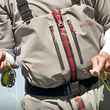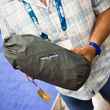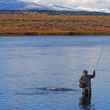The slate-gray skies presiding over the chop of a gusty Ascension Bay told us all we’d need to know as the panga bounced and banged its way around Punta Allen and into the backcountry. We were bundled up in our jackets to fight off the morning chill that, unfortunately, hung on long into the February day in the Yucatan tropics.
“All we can do is try,” said Antonio, one of the two guides braving the winter weather with us this day. And, of course, “winter weather” is tongue-in-cheek. It was a hair above 70 degrees—perfectly pleasant for a couple of gringos fresh out of an Idaho blizzard and the massive dump Philly got in the Snowmageddon of 2016.
But on the flats, it’s about warmth, sun and nervous water. You don’t need all three, but at least one is sure nice when you’re trying to spot cruising bones or tailing permit.
Despite the less-than-ideal conditions, and the fact that the two days prior had us facing much of the same, we stuck with it for the morning, searching for fish in the green water that was shadowed by thick clouds and whipped into a milky froth by a cursed north wind. Nothing.
Finally, at lunch, we buckled.
More Like This
“Is there a spot where we can just cast for jacks and snappers and feel the pull for a while?” I asked, frustrated at the blustery weather and the dark sky.
The guides, both of whom know that the mission for most anglers on the flats of Ascension Bay flats is primarily permit, with bonefish coming in a close second, exchanged a somewhat unenthusiastic glance.
“I guess we could take you to the jack channel,” Antonio said, a bit sheepishly. His eyes brightened when he saw the faces of two dejected anglers turn from sour to encouraged. We’d each spent about three hours standing on the casting platform that morning glaring out over a monotone seascape with nothing but some lower back cramps to show for it. The idea of casting to jacks and snappers and having follows, hits and hook-ups on every cast seemed pretty damned attractive.
It reminded me of those days, years ago, when, as kids, we’d venture out onto the roily waters of Lake Tyler in East Texas in a rickety old rowboat in search of largemouth bass on plugs and lures. Usually, we wouldn’t do so well. But, we knew, when we got back to the pier and all the boat slips that we’d be able to switch those lures for tiny black and yellow Beetlespin lures and catch bluegills, bream and sunfish up against the docks until our arms tired.
And, of course, it proved to be true. When nothing is happening … well … something is happening. You just have to adjust your expectations. And the blue runners, yellowtails and horseheads (all those catch-all “jacks” of the bay) were happening. In a big way.
The guides didn’t even bother changing flies on the permit rod. We’d been after permit in neck-deep water using a heavy, shrimpy pattern for that particular reach of the bay, and when we got to the “jack channel”—a slice in the sand-bottomed bay carved out by two conflicting currents and the winter wind—that fly did plenty of damage. We traded spots on the casting platform every few minutes, shaking small blue runners off the hook and occasionally boating something a bit more respectable. In addition to an untold number of jacks, we also brought to hand one of the biggest bones of the trip, proof that structure and depth, even in the seemingly endless flats of the bay, matter. And, as if to suggest that the universe approved, for just a little while the clouds parted and the sun appeared, illuminating the bay and setting its myriad colors ablaze.
But the jacks dominated the catch. And jacks pull. Hard.
“If a 20-inch brown trout pulled as hard as that 8-inch jack, I’d never need to come to the salt to fish,” I said, as Antonio unhooked one of probably a dozen blue runners that were, quite literally, the size of a really nice bluegill. But the fight even a small jack puts up is enough to bend an 8-weight, and the two or three legitimate 2-pounders we caught were enough to restore hope to an otherwise, tough day in tough elements chasing permit, perhaps the most challenging of fly rod targets.

Atlantic jacks (they have Pacific cousins, too) range from the tropics and into temperate waters, as far north in the summer as Chesapeake Bay. Perhaps the most willing—and certainly one of the most ferocious—fly rod targets for inshore fishermen, these muscled fish are often underappreciated, especially the juvenile versions like the ones we were catching at a feverish clip. The mature fish—female jacks actually get bigger than males—are much more challenging to catch, and they can make mush out of flats tackle. My friend Rhett Shrober, a part-time guide out of Akumal, laughed at me when I told him I was casting to big jacks near Tulum on a DIY trip earlier this winter with only 15-pound bite tippet.
“Did you catch any?” he asked.
“Nope. Nobody home,” I said.
“You’re damn lucky. They would have destroyed that tippet. You need 30- or even 40-pound shock tippet for the big ones,” he said. And by big ones, he’s talking giant slices of saltwater protein that weigh 20 pounds or more.
But for those few precious moments spent casting into that deep cut—that karmic switch-a-roo, if you will—we went from skunked to pumped, and, as if by magic, the sun poked through the clouds and we chased it around the bay that afternoon, fortunate enough get a couple of legitimate permit shots, despite less-than-stellar conditions.
The “bluegill of the bay” saved the day.

































Comments